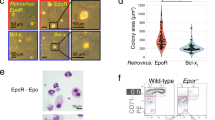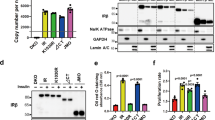Abstract
The role of insulin (INS), and insulin-like growth factor-I (IGF-I) in the regulation of human erythropoiesis is not completely understood. To address this issue we employed several complementary strategies including: serum free cloning of CD34+ cells, RT-PCR, FACS analysis, and mRNA perturbation with oligodeoxynucleotides (ODN). In a serum-free culture model, both INS and IGF-I enhanced survival of CD34+ cells, but neither of these growth factors stimulated their proliferation. The influence of INS and IGF-I on erythroid colony development was dependent on a combination of growth factors used for stimulating BFU-E growth. When BFU-E growth was optimally stimulated with erythropoietin (EpO) + kit ligand (KL) the large erythroid colonies developed normally even in the absence of INS or IGF-I. However, the addition of both of these growth factors slightly enhanced colony size. On the other hand, if eruthroid colonies were stimulated suboptimally with EpO + IL-3 only, INS or IGF-I increased the number of small erythroid bursts by ∼30%. Both INS and IGF-I activated signal transduction in maturing human erythropoietic cells as determined by phosphorylation of the insulin receptor substrate-2 (IRS-2) protein. We also found by RT-PCR that mRNA coding for INS-R is expressed in FACS sorted CD34+, c-kit-R+ marrow cells, and in cells isolated from BFU-E and CFU-GM colonies. Expression of INS-R protein on these cells was subsequently confirmed by cytofluorometry. In contrast, the receptor for insulin-like growth factor-I (IGF-IR) was not detected on CD34+ cells, and was first easily detectable on more differentiated cells derived from day 6 BFU-E and CFU-GM colonies. We conclude that INS and IGF-I may be survival factors for human CD34+ cells, but are not required during early erythropoiesis. In contrast, both growth factors may play some role at the final stages of erythroid maturation.
This is a preview of subscription content, access via your institution
Access options
Subscribe to this journal
Receive 12 print issues and online access
$259.00 per year
only $21.58 per issue
Buy this article
- Purchase on Springer Link
- Instant access to full article PDF
Prices may be subject to local taxes which are calculated during checkout
Similar content being viewed by others
Author information
Authors and Affiliations
Rights and permissions
About this article
Cite this article
Ratajczak, J., Zhang, Q., Pertusini, E. et al. The role of insulin (INS) and insulin-like growth factor-I (IGF-I) in regulating human erythropoiesis. Studies in vitro under serum-free conditions – comparison to other cytokines and growth factors. Leukemia 12, 371–381 (1998). https://doi.org/10.1038/sj.leu.2400927
Received:
Accepted:
Published:
Issue Date:
DOI: https://doi.org/10.1038/sj.leu.2400927
Keywords
This article is cited by
-
Fetoplacental oxygen homeostasis in pregnancies with maternal diabetes mellitus and obesity
Nature Reviews Endocrinology (2022)
-
Red Blood Cells Mean Corpuscular Volume (MCV) and Red Blood Distribution Width (RDW) Parameters as Potential Indicators of Regenerative Potential in Older Patients and Predictors of Acute Mortality – Preliminary Report
Stem Cell Reviews and Reports (2020)
-
An Overview of Novel Unconventional Mechanisms of Hematopoietic Development and Regulators of Hematopoiesis – a Roadmap for Future Investigations
Stem Cell Reviews and Reports (2019)
-
Association of adiposity with hemoglobin levels in patients with chronic kidney disease not on dialysis
Clinical and Experimental Nephrology (2018)
-
Prolonged Growth Hormone/Insulin/Insulin-like Growth Factor Nutrient Response Signaling Pathway as a Silent Killer of Stem Cells and a Culprit in Aging
Stem Cell Reviews and Reports (2017)



